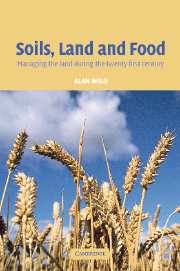Book contents
- Frontmatter
- Contents
- Preface
- Acknowledgements
- 1 Managing land for food production in the twenty-first century: an outline
- 2 Natural resources for sustainable land management
- 3 The development of agriculture and systems of land management
- 4 Maintaining and improving soil fertility
- 5 Land degradation and its control
- 6 Raising yields: use of fertilizers
- 7 Raising yields: water for rainfed crops and irrigation
- 8 Managing change of land use: seven examples
- 9 Increasing and sustaining agricultural production
- 10 Increasing agricultural production: the examples of Africa, India and China
- 11 Prospects and uncertainties
- References
- Index
9 - Increasing and sustaining agricultural production
Published online by Cambridge University Press: 05 June 2012
- Frontmatter
- Contents
- Preface
- Acknowledgements
- 1 Managing land for food production in the twenty-first century: an outline
- 2 Natural resources for sustainable land management
- 3 The development of agriculture and systems of land management
- 4 Maintaining and improving soil fertility
- 5 Land degradation and its control
- 6 Raising yields: use of fertilizers
- 7 Raising yields: water for rainfed crops and irrigation
- 8 Managing change of land use: seven examples
- 9 Increasing and sustaining agricultural production
- 10 Increasing agricultural production: the examples of Africa, India and China
- 11 Prospects and uncertainties
- References
- Index
Summary
INTRODUCTION
The previous chapter described several routes that agricultural development can take, depending on the biological, physical and economic conditions. In this chapter the requirements for more agricultural land and for higher yields will be considered in relation to the greater population of the twenty-first century, particularly in two groups of developing countries.
Between 1995 and 2050 the world population (on the medium variant; see Figure 1.1) will increase by 3.2 billion (57 per cent), all of which will be in less developed countries, where it represents an increase of 72 per cent (United Nations, 1999). Production of food will need to increase likewise to maintain the present nutritional standards. A greater rate of increase will be needed if the diets of many people in developing countries are to be improved (in terms of both calories and nutritional worth) and allowance is made for the increasing consumption of animal products.
According to FAO data, between 1961 and 1995 production per person rose by 18 per cent as an average for the world population. An increase occurred in all regions except sub-Saharan Africa, where it remained almost unchanged. However, projections for the future by FAO are for the rate of increase in production to become less. A country's food requirements in the future can be met, as in the past, by growing crops on more land, by raising annual yields or by importing food, or by a combination of these methods.
- Type
- Chapter
- Information
- Soils, Land and FoodManaging the Land during the Twenty-First Century, pp. 155 - 182Publisher: Cambridge University PressPrint publication year: 2003



